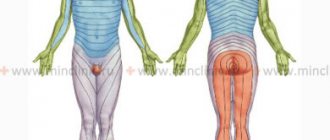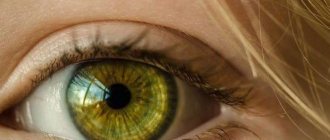Pain above the eyebrows - causes
Trigeminal neuralgia
Trigeminal neuralgia is a condition that causes sharp, intense pain in the facial area. The trigeminal nerve connects the brain to the face, allowing a person to sense touch and changes in temperature.
Trigeminal neuralgia usually affects only one side of the face, but in rare cases it can affect both sides.
Some people with this condition may experience stabbing pain that feels like an electric shock. Others may have constant pain and burning in the facial area.
Possible diseases
In some cases, the head hurts in the forehead and there is pressure due to pathologies of the internal organs. Associated diseases:
- infections: acute respiratory viral infections, acute respiratory infections (cause a rise in temperature and intoxication, which is why the head hurts and puts pressure on the forehead);
- ENT diseases: sinusitis, ethmoiditis, frontal sinusitis (a characteristic symptom is severe nasal congestion);
- inflammation of the membranes of the brain: encephalitis, meningitis (accompanied by fever);
- pathologies of the nervous system: migraine (pain intensifies due to sounds, bright light, and recedes in silence and darkness), neuralgia (sharp, severe pain);
- injuries: concussions, skull fractures, bruises of the soft tissues of the head;
- diseases of the cardiovascular system: changes in intracranial pressure, hypertension, atherosclerosis, neurocirculatory dystonia;
- endocrine disorders: pathologies of the thyroid gland, adrenal glands;
- ophthalmological diseases: changes in intraocular pressure, uveitis, inflammation of the optic nerve, myopia;
- oncological pathologies: brain tumor, neoplasms in the sinuses or pituitary gland.
Headaches in the forehead area can occur against the background of a large number of diseases. A comprehensive examination of the body will allow you to identify and eliminate the provoking factor.
Cluster headache
A cluster headache is a severe headache that can occur one to eight times a day and last from 15 minutes to 3 hours each time.
People may experience stabbing pain, often either behind the eyebrow and eye, or around the temples. This pain and other symptoms usually affect one side of the head.
Cluster headache symptoms
- red, watery eyes;
- runny nose;
- flushed face;
- drooping eyelid;
- hyperkinesis;
- inability to lie still.
Shingles
Shingles is a condition that affects the nerves. It occurs in localized areas, usually on one side. These areas may include the face and neck.
Symptoms of herpes zoster
- a painful, fluid-filled rash;
- shooting pain;
- tingling or numbness sensation;
- burning;
- itching;
- fever and chills;
- nausea;
- headache;
- loss of vision.
People should see a doctor immediately if they notice blisters on their face, especially if they are close to the eyes.
Sinusitis
Sinusitis is an inflammation of the sinuses. This can put a lot of pressure on the facial area and people may feel pain around the eyebrows, nose, forehead and cheeks.
Symptoms of sinusitis
- stuffy nose;
- cough;
- thick, yellow or green mucus from the nose;
- mucus running down the throat.
Sinusitis can be either acute or chronic. Symptoms of acute sinusitis usually resolve within a week or 10 days. If symptoms do not improve with treatment and last longer than 12 weeks, a person may develop chronic sinusitis.
Temporal arteritis
Giant cell arteritis, or temporal arteritis, is a condition that affects the blood vessels along the side of the head.
Inflammation of these blood vessels can cause facial pain and other symptoms such as:
- jaw pain;
- temporary loss of vision;
- fever;
- severe headaches;
- dizziness;
- difficulty swallowing or sore throat.
According to the Arthritis Foundation, people over 50, especially women, are more likely to develop giant cell arteritis.
Treatment and home remedies
Treatment for eyebrow pain depends on the cause:
- Headaches and migraines: Painkillers, as well as more rest and sleep, may help.
- Severe or frequent migraine episodes: Your doctor may prescribe pain medications.
- Cluster headaches: Your doctor may recommend pain medications or an oxygen mask to prevent a cluster headache.
- Shingles: Rest, a cool compress, and calamine lotion can help soothe the symptoms of shingles until the infection clears up.
- Glaucoma: Taking eye drops daily may help prevent vision loss in people with glaucoma. Beta blockers and alpha agonists also help reduce fluid buildup in the eye.
- Sinusitis: Patients can take anti-inflammatory medications and nasal sprays to treat sinusitis. Pain medications, adequate rest, and proper hydration may also help reduce symptoms.
- Trigeminal neuralgia: Your doctor may prescribe medications or recommend surgery.
- Giant cell arteritis: Corticosteroids can effectively treat the symptoms of giant cell arteritis.
Treatment
Headaches cannot be tolerated, so during attacks you should take analgesics. These can be drugs based on paracetamol, ibuprofen, ketorol and others that help a particular patient.
The main treatment for headaches is always aimed at their cause. If there are serious pathologies of internal organs, hormone or chemotherapy, drugs for migraines or epilepsy, and drugs for heart disease are prescribed. Treatment is selected individually, taking into account the results of the examination and the general condition of the patient.
Dear patients!
Remember that only a qualified doctor can make an accurate diagnosis, determine the causes and nature of the disease, and prescribe effective treatment. You can make an appointment with our specialists or call a doctor at home by calling 8-(4822)-33-00-33 Be healthy and happy!
When to see a doctor?
A person should see a doctor if eyebrow pain is severe, persistent, or accompanied by other symptoms.
People with eyebrow pain should seek immediate medical attention if they also have the following symptoms:
- severe pain or swelling of the face;
- swelling or redness around the eyes;
- confusion or feelings of disorientation;
- sudden severe headache;
- drowsiness;
- fever;
- rash;
- nausea and vomiting.
People should see a doctor if they have symptoms of any of the following conditions:
- shingles;
- giant cell arteritis;
- severe or frequent migraine episodes;
- trigeminal neuralgia;
- glaucoma.
Causes
If a patient has a forehead pain due to a runny nose, then he needs to see a specialist and undergo an examination. The appearance of discomfort in this area is a sign of complications of rhinitis, which can lead to serious consequences. Therefore, patients should undergo examination as quickly as possible.
Viral infections
The cause of pain in the forehead can be a viral infection. As the pathological agent multiplies inside the human body, the patient develops severe intoxication, one of the manifestations of which is a severe headache. Most often, unpleasant sensations are localized in the frontal part of the skull, which leads to the occurrence of a symptom. In addition to pain in the forehead, during viral infections discomfort also affects the temporal parts of the skull.
Colds
Often a person has a sore forehead between the eyebrows if he has colds. The process most often occurs against the background of hypothermia, weakened immunity and other adverse influences from the external environment. In addition to pain in the forehead, the patient experiences the following symptoms:
- general weakness;
- difficulty breathing through the nose;
- fever, high temperature;
- nausea.
The presence of a characteristic symptom complex is complemented by catarrhal manifestations from the nasal cavity - copious mucous or purulent discharge from the nasal passages.
Rhinitis of various forms
Rhinitis is an inflammatory process that spreads to the mucous membrane of the nasal cavity. Due to the proximity of the nasal passages and the forehead area, many patients may experience local pain as the disease develops.
Rhinitis is a polyetiological disease that can be caused by a number of factors. The main forms of pathology include:
- infectious rhinitis. The inflammatory process in this form of the disease occurs due to invasion of the nasal cavity by pathogenic microorganisms. These can be either bacteria or viral particles that stimulate the development of infection and the appearance of a runny nose along with pain in the forehead.
- Allergic rhinitis. Specific inflammatory processes in the nasal cavity often occur against the background of allergies. If a person inhales a pathological substance, he develops a hypersensitivity reaction. Its appearance also leads to a runny nose and causes pain in the forehead with rhinitis.
- Vasomotor rhinitis. Copious nasal discharge is often explained by impaired tone in the local arteries of the nasal passages. Due to changes in the vascular wall, plasma escapes into local tissues, and the mucous membrane swells greatly. Vasomotor disorder often occurs against the background of hypertension and other vascular diseases, the manifestations of which also include pain in the forehead.
Less commonly, the appearance of an unpleasant symptom may be associated with other forms of rhinitis - an atrophic or hypertrophic process in the nasal cavity.
Sinusitis
If a person has a sore forehead after a runny nose, then he should have his sinuses examined. The pathological process from the nasal cavity often spreads to the nearby sinuses, which are also covered with mucous membrane. Its inflammation leads to the development of a special group of diseases – sinusitis.
Depending on which sinus is affected, the patient experiences one or another type of illness. The most common form of pathology is sinusitis - inflammation of the maxillary sinuses. The disease usually develops after a long-term presence of an inflammatory process in the nasal cavity in the absence of proper treatment.
The patient begins to have pain in the bridge of his nose and forehead when he has a runny nose, the sensations usually have a bursting, aching character, it is constantly present, which significantly worsens the patient’s condition. The sensation usually increases when pressing on the skin in the sinus area.
Sometimes, when changing body position, the patient feels that there is “liquid splashing” in the area under the eye sockets. This is due to the fact that the contents of the maxillary sinus move with movement.
In addition to pain in the forehead, the following symptoms indicate that the sinuses are inflamed:
- increased body temperature;
- thick purulent nasal discharge, which usually has an unpleasant odor;
- increased weakness, impaired performance.
The appearance of sinusitis is also indicated by symptoms of damage to the eyeballs, which are located next to the inflamed sinus. The patient develops increased lacrimation and photophobia. Often, as a result of the disease, pain in the eyes and severe redness of the cornea occurs due to damage to local vessels.
Frontit
More rare sinusitis includes frontal sinusitis, an inflammatory process in the cavity of the frontal sinus. This disease also develops due to a long course of chronic or acute rhinitis. It is characterized by copious mucous discharge from the nasopharynx .
The main manifestation of the disease is pain in the forehead. The patient constantly feels a squeezing, bursting pain that is acute. Unpleasant sensations intensify when turning the head, as well as when changing body position.
Other manifestations of frontal sinusitis are similar to the symptoms of sinusitis. However, when the frontal sinus is affected, several symptoms specific to this disease are identified. These include:
- severe swelling of the eyelids, bridge of the nose and skin on the forehead;
- impaired sense of smell;
- pain when pressing on the skin in the upper part of the face.
Frontal sinusitis is a particularly dangerous disease due to the fact that the frontal sinus is located directly close to the brain.
Ethmoiditis
Ethmoiditis is a rare complication of rhinitis, which manifests itself as an inflammatory process in the cavity of the ethmoid bone of the skull. Sinus damage is manifested by severe pain, spreading not only to the forehead, but also to the temples. This localization can be considered a specific sign of inflammation of the ethmoid sinus.
To protect yourself from nasal inflammation, it is necessary to carry out special treatment for a runny nose. Prevention of ethmoiditis is very important, since the pathology has severe complications. Against the background of the inflammatory process in the ethmoid bone, the eyeballs suffer, which change their position in the orbital cavity. Due to the pathology, the patient’s visual acuity decreases; with long-term sinusitis, complete blindness may develop due to the transition of the pathological process to the eye tissue.
Sphenoiditis
If the patient has a runny nose and a sore forehead, then this combination of symptoms may be the basis of another sinusitis - sphenoiditis. This pathology occurs due to the transition of inflammation from the nasal cavity to the adjacent sphenoid sinus.
The disease has a clinical picture characteristic of sinusitis. In addition to the general symptoms of sphenoiditis, the patient suffers from complete or partial loss of smell, as well as visual impairment.
Otitis
Otitis is an inflammatory process that affects the mucous membrane of the inner ear. The connection between this disease and a runny nose is explained by the fact that the nasal cavity is in contact with the ear canal through a special anatomical formation - the Eustachian tube. The spread of infection into the nasal passages leads to a runny nose, which is combined with manifestations of otitis media (fever, pain in the temples and forehead area).
Meningitis
The most dangerous disease in which the frontal part of the head hurts is meningitis - an inflammatory process affecting the membranes covering the brain. The disease has an acute course with a sharp increase in temperature, accompanied by nausea and bouts of repeated vomiting. Afterwards, the person’s condition quickly deteriorates, with acute headaches, confusion, and muscle weakness. If left untreated, the infection quickly becomes generalized. Against the background of pathology, a coma may develop, which can be fatal. Therefore, the appearance of symptoms of meningitis is a reason to consult a doctor for emergency medical help.
Summary
People may experience eyebrow pain for many reasons. Sinusitis or headaches can lead to increased pressure and pain in the eyebrow area, which should go away as soon as the cause is eliminated. Other times, eyebrow pain is due to an underlying condition such as glaucoma.
If people experience frequent or severe pain around the eyebrows or notice other symptoms, they should consult a doctor immediately.
Another article on the topic: Drinking small amounts of caffeine every day does not cause migraines.
Symptoms and signs of frontal sinusitis
Depending on which frontal sinus is inflamed, frontal sinusitis can be unilateral or bilateral. More often it is the left- or right-sided form, when the left or right sinus is affected. In this case, pain and swelling appear only on one side of the face. For unilateral frontal sinusitis there are other characteristic signs:
- body temperature 37.3-39°C;
- mucopurulent and mucous discharge from the nose;
- deterioration of nasal breathing and sense of smell;
- moderate headache in the superciliary area;
- a feeling of pain and discomfort in the inner corner of the eye.
With bilateral frontitis, the patient feels much worse than with unilateral frontitis. He is deprived of free breathing from both nostrils at once. Because of this, pain is more pronounced, as well as a feeling of fullness in the forehead. Discharge also occurs from both nostrils.
In mild forms of frontal sinusitis, predominantly local symptoms appear. In the case of a moderate course, signs of intoxication appear: the temperature rises, weakness and malaise appear, loss of appetite and worsening sleep are observed. With severe frontal sinusitis, more severe symptoms occur:
- severe, sometimes unbearable pain in the forehead;
- reactive swelling of the eyelids;
- swelling and redness of the skin in the projection area of the frontal sinus;
- puffiness of the face;
- photophobia;
- lacrimation.
Painful sensations
Pain in the forehead increases when tilting or moving the eyeballs. It can radiate to the temporoparietal region. If the patient sleeps on his back, then in the morning he experiences sharp exacerbations of pain. This is due to the accumulation of inflammatory masses in the frontal sinuses.
Discharge
Initially, the patient experiences a thin, mucous discharge. They are transparent, but over time they become viscous and acquire a yellow tint. The development of a purulent process is indicated by green discharge with an unpleasant odor. With unilateral frontal sinusitis, they come out of only one nostril, and with bilateral sinusitis, they come out of both nostrils at once.
Acute frontal sinusitis
Acute frontal sinusitis is characterized by a sharp onset and persistence of symptoms for up to 12 weeks. If the patient receives high-quality treatment, then complete recovery without residual signs is possible. The main symptoms of acute frontal sinusitis include:
- pressing or aching pain in the forehead (intensified by tapping);
- discharge of purulent sputum from the nose in the morning;
- sharp pain in the inner corner of the eye when pressing;
- feeling of fullness in the area between the eyebrows;
- elevated temperature.
Chronic frontal sinusitis
The transition of frontal sinusitis to a chronic form is associated with the lack of treatment or incorrectly selected therapy. A chronic process is said to occur when a person does not recover for more than 12 weeks. Symptoms characteristic of acute frontal sinusitis become less pronounced in the chronic form. The patient is concerned about the following manifestations:
- malaise that prevents you from doing your usual things;
- sometimes the temperature rises to 37°C;
- nasal congestion in the morning;
- persistent cough that is not helped by antitussive medications;
- swelling of the walls of the eye sockets in the morning;
- deterioration of sense of smell;
- feeling of heaviness behind the eyes.
Breathing problems in chronic frontal sinusitis are associated with the growth of polyps in the nasal cavity. Discharge in chronic frontal sinusitis may be absent. The first sign of an exacerbation of the disease is a feeling of “heat” or “flush” in the forehead. Only then does pain appear in this area. It intensifies with bending over and physical activity, and is sometimes accompanied by pulsation.
Catarrhal
The term “catarrhal” means “superficial.” This type of frontitis is accompanied by pain in the area of the brow ridges, which often torments the patient at night and 1 hour after waking up. It radiates to one or both eyes and jaw. Around lunchtime the pain goes away.
The catarrhal form is considered the first stage of the inflammatory process in the frontal sinuses. In addition to pain, the disease causes the following symptoms:
- temperature increase;
- photophobia;
- sleep problems;
- increased tearfulness;
- decreased performance and fatigue;
- swelling of the mucous membrane of the sinuses themselves, which leads to nasal congestion.
Purulent
One of the most dangerous forms of the disease is acute purulent frontal sinusitis. It can quickly lead to inflammation of the periosteum, cellulitis and osteomyelitis. This is due to the fact that the source of inflammation is located near vital organs. The purulent-necrotic process can spread to brain tissue and craniofacial nerves, which is dangerous for the development of sepsis, meningitis, and sometimes even death. Purulent frontal sinusitis can be recognized by the following symptoms:
- temperature 39-40°C;
- purulent nasal discharge;
- throbbing pain in the forehead, which intensifies when tilting and turning the head;
- cough at night and in the morning;
- Strong headache;
- photophobia;
- severe nasal congestion;
- tearfulness;
- tension and swelling in the bridge of the nose.
Do you have symptoms of frontal sinusitis?
Only a doctor can accurately diagnose the disease. Don't delay your consultation - call








